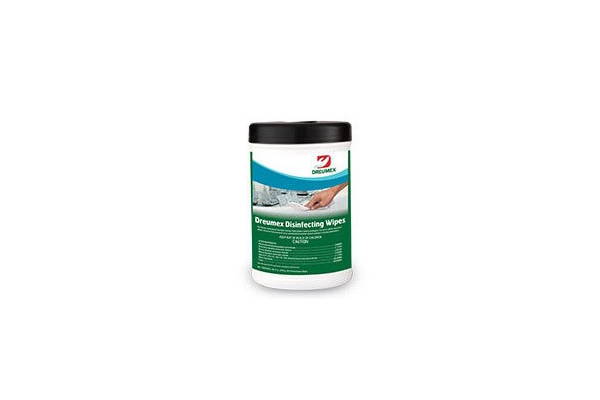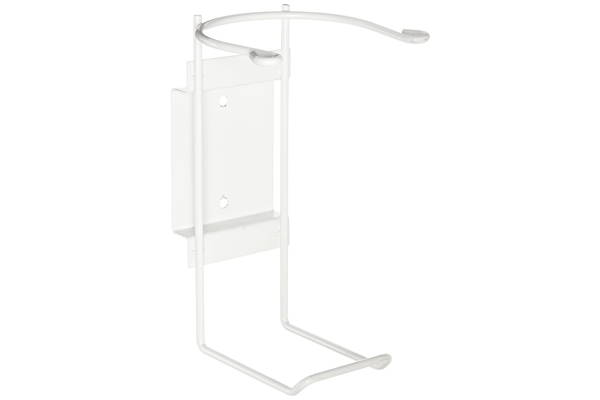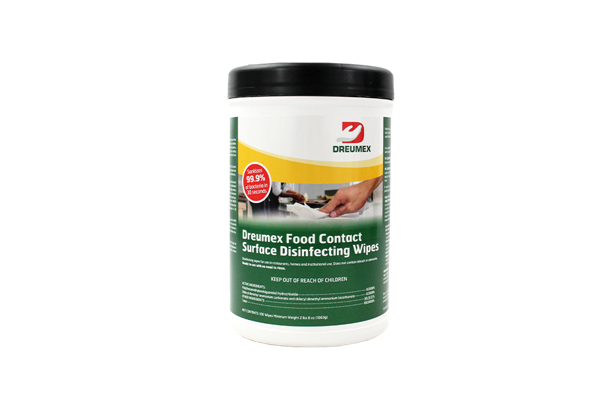
Dreumex Disinfecting Wipes
- Effective in only 2 minutes
- Kills SARS-CoV-2 (COVID-19) in 1 minute
- Great for high traffic areas such as doctor’s offices, long-term care centers, waiting rooms & fitness centers
Request a quote
High performance disinfecting wipes against bacteria, yeast and enveloped viruses (BVDV). Dreumex Disinfecting Wipes kill 52 bacteria and viruses, including Norovirus, MRSA, Staph, Salmonella, E.coli & Rotavirus. Also kills 14 of the 20 HAI (healthcare associated infections) and provide multi-surface disinfection with little-to-no lint. Recommended for use on hard, non-porous surface in restaurants, food processing plants, schools, office buildings, athletic facilities and other institutions.
- Do not use as a diaper wipe or for personal cleansing.
- This is not a baby wipe!
- Do not flush.
- For plastic and painted surfaces, spot test on an inconspicuous area before use.Dreumex Disinfecting Wipes will not harm most surfaces: including acrylic, sealed fiberglass and vinyl. Note: Do not use on unpainted wood, natural marble or brass.
- To clean and deodorize:
- Wipe surface with wipe.
- Let air dry.
- Discard used wipe in trash.
- To clean and disinfect:
- Wipe hard, nonporous surface with wipe until surface is visibly wet.
- Allow surface to remain wet for 2 minutes.
- For Serratia marcescens, treated surfaces must remain wet for 5 minutes.
- For Feline Calicivirus and Norovirus, treated surfaces must remain wet for 10 minutes.
- If surfaces are extremely dirty, clean first with another wipe before disinfecting.
- Discard used wipe in trash.
- Do not flush.
- Rinse food contact surfaces with clean, potable water after disinfecting.
- Do not use to disinfect dishes, glassware or utensils.
- Fungi: For Candida albicans control, follow disinfection directions.
- Refer to product labeling for full directions of use.
- This product is not for use on medical device surfaces.
| Bacteria: |
| - Pseudomonas aeruginosa (Pseudomonas) |
| - Salmonella enterica (Salmonella) |
| - Staphylococcus aureus (Staph) |
| - Acinetobacter baumannii |
| - Acinetobacter baumannii, Multi-Drug Resistant (MDR) |
| - Burkholderia cepacia |
| - Campylobacter jejuni (Campylobacter) |
| - Enterobacter aerogenes |
| - Enterococcus faecalis (Enterococcus) |
| - Enterococcus faecalis – Vancomycin Resistant (VRE) |
| - Escherichia coli (E. coli) |
| - Escherichia coli – NDM-1 Positive |
| - Escherichia coli O157:H7 |
| - ESBL Escherichia coli – (Extended spectrum beta-lactamase producing E. coli) |
| - ESBL Klebsiella pneumoniae • Klebsiella pneumoniae (Klebsiella) |
| - Klebsiella pneumoniae – NDM-1 Positive |
| - Listeria monocytogenes |
| - Proteus vulgaris |
| - Salmonella enterica serovar Typhi (Salmonella) |
| - Serratia marcescens (Serratia) |
| - Shigella dysenteriae (Shigella) |
| - Staphylococcus aureus - Community Associated Methicillin-Resistant (CA-MRSA) (NRS384) (USA300) (NARSA NRS 384) |
| - Staphylococcus aureus - Community Associated Methicillin-Resistant (CA-MRSA) (NRS123) (USA400) (NARSA NRS 123) |
| - Staphylococcus aureus - Methicillin-Resistant (MRSA) |
| - Staphylococcus aureus - Multi-Drug Resistant |
| - Staphylococcus aureus - Vancomycin Intermediate Resistant – (VISA) |
| - Staphylococcus aureus - Vancomycin Resistant – (VRSA) (NARSA VRS1) |
| - Streptococcus pneumoniae – Penicillin Resistant |
| - Streptococcus pyogenes (Strep) (associated with scarlet fever) |
| - Vibrio cholerae |
| Viruses: |
| - Hepatitis B Virus (HBV) |
| - Hepatitis C Virus (HCV) |
| - Herpes Simplex Virus Type 1 |
| - Herpes Simplex Virus Type 2 |
| - HIV-1 (AIDS Virus) |
| - Human Coronavirus |
| - Human Influenza A Virus (H7N9) |
| - Influenza A Virus / Hong Kong (H3N2) |
| - Influenza A Virus / Hong Kong |
| - 2009-H1N1 Influenza A Virus (Novel H1N1) |
| - Norwalk Virus (Norovirus) |
| - Respiratory Syncytial Virus (RSV) |
| - Rotavirus |
| - SARS Associated Coronavirus (SARS) (cause of Severe Acute Respiratory Syndrome) |
| Animal Viruses: |
| - Avian Influenza Virus (H3N2) |
| - Avian Influenza Virus (H5N1) |
| - Feline Calicivirus |
| - Murine norovirus |
| Fungi: |
| - Candida albicans |
| Appearance | Pre-moistened wipe |
| Scent | None |
| Ingredients | Water (diluent), Alkyl (50%C14, 40%C12, 10%C16) dimethyl benzyl ammonium chloride (active), Octyl decyl dimethyl ammonium chloride (active), Polyaminopropyl Biguanide (active), Didecyl dimethyl ammonium chloride (active), EDTA (chelating agent), Dioctyl dimethyl ammonium chloride (active), Monoethanolamine (solvent), Silica Dimethicone Silylate (surfactant) |

Canister
| Packing | Canister |
| Content | 150 wipes |
| Content (box) | 6 |
| Article No. | 64301503001 |
Dreumex Disinfecting Wipes can be used as a convenient way to disinfect hard, non-porous surfaces in gyms, restaurants, food processing plants, schools, office buildings, athletic facilities and other institutions.
Dreumex Disinfecting Wipes provides a high performance against bacteria, Yeast and enveloped viruses (Vaccinia virus, BVDV, Murine Norovirus).
Grab a wipe, wipe your equipment till it’s visibly wet. Let air dry and discard the wipe in trash.
Yes, of course. No alcohol-, aldehyde-, chlorine or VOC is used in Dreumex Disinfecting Wipes. The wipes are safe for your equipment without risk of damaging or discolouring.
No, the Dreumex Disinfecting wipes are for single use
Rinsing is not necessary.
No, Dreumex Disinfecting Wipes are designed to disinfect surfaces only.
There are several reasons for this. The main reason are: 1. Dreumex Disinfecting Wipes are ready to use 2. Dreumex Disinfecting Wipes are safe for your equipment 3. Dreumex Disinfecting Wipes are completely disposable You can find all the reasons in this leaflet.
Used Dreumex Disinfecting Wipes can be disposed of in the trashcan (with the residual waste).
No, it is not recommended to flush the wipes down the toilet. The wipes can be thrown in the trashcan after use (with the residual waste).
No
Probably after using the wipes the packaging is not properly closed for a long time, which has caused the cloths to dry out. If the cloths have dried out, they can no longer be used.




